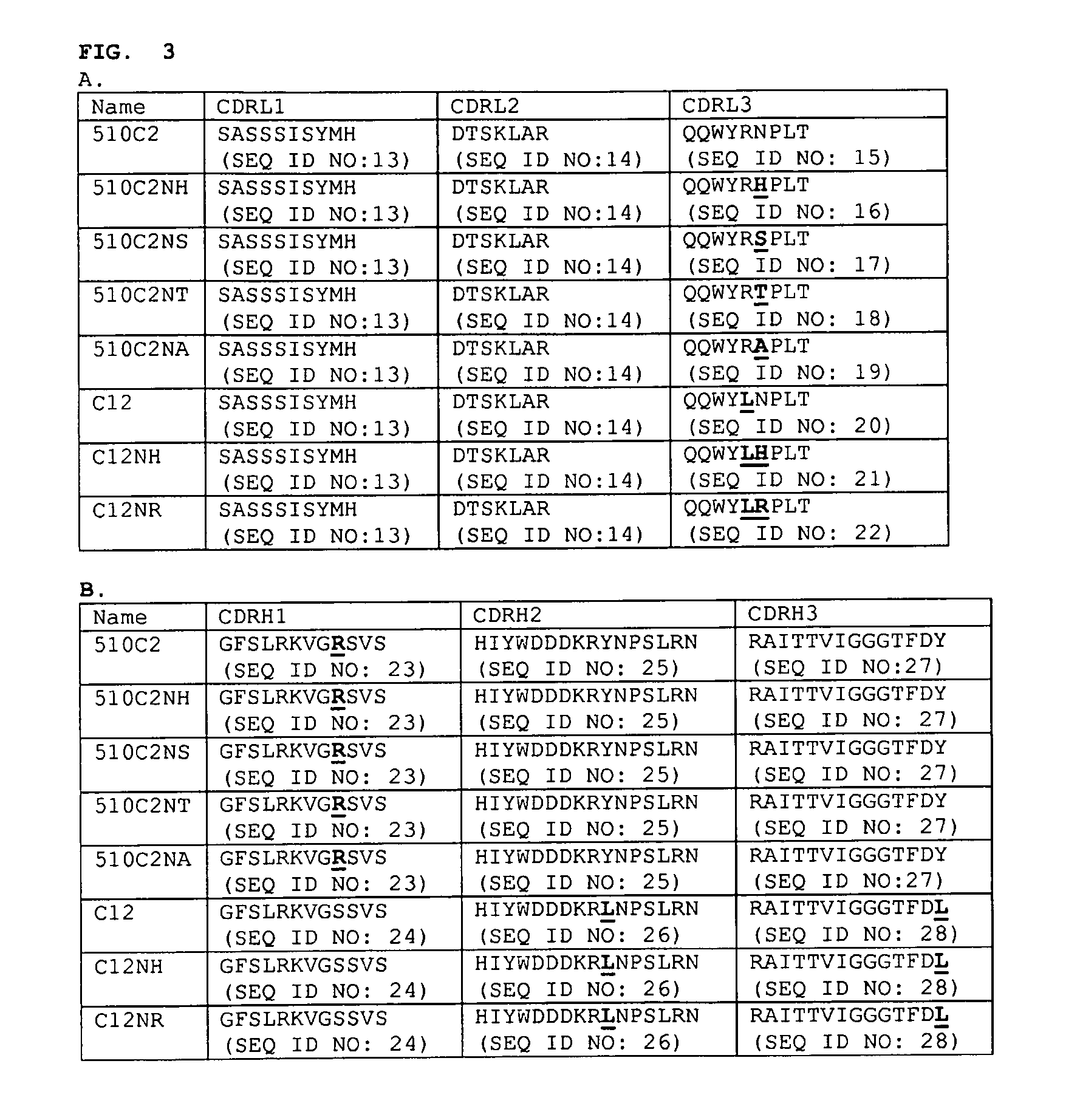Anti-myostatin antibodies
a monoclonal antibody and myostatin technology, applied in the field of medicine, can solve the problems of aqueous solution cleavage of asparagine residues in antibodies or other polypeptides, and achieve the effects of preventing muscle wasting, preventing age-related sarcopenia, and preventing muscle wasting
- Summary
- Abstract
- Description
- Claims
- Application Information
AI Technical Summary
Benefits of technology
Problems solved by technology
Method used
Image
Examples
example 1
Identification of a Cleavage Site in Mabs C12 and 510C2
[0089]Solutions of antibodies at 1 mg / mL in various buffer conditions (10 mM citrate pH 5, 10 mM citrate pH 6, 10 mM citrate pH 7, and 10 mM citrate / 150 mM NaCl pH 7), are incubated at multiple temperatures (−20° C., 4° C., 25° C., and 40° C.) for 4 weeks. Following incubation, samples are characterized by sodium-dodecylsulfate polyacrylamide gel electrophoresis. For antibodies containing the variable domain of C12 or 510C2 (in multiple Fc-isotypes), additional bands, beyond the expected bands for the heavy and light chains of the antibody, are observed. These bands are observed only for samples incubated at pH 7 (with or without NaCl); under sample reducing conditions, two bands are observed, with apparent masses of ˜8-10 kDa, and ˜12-14 kDa, and under non-reducing conditions, a single band with an apparent mass of ˜8-10 kDa is observed. The extent of cleavage, as determined by the relative intensities of these bands appears to...
example 2
Removal of the Chemical Cleavage Site in the C12 and 510C2 Antibodies
[0094]To remove the cleavage site in C12 and 510C2, single amino acid substitutions of each individual amino acid are used to replace the asparagine residue in CDRL3 of both monoclonal antibodies. ELISA is used to determine the effects of the individual amino acid substitutions on affinity to myostatin compared to C12 or 510C2 Fabs.
[0095]ELISA plates are coated with myostatin diluted to 4 ug / ml in carbonate buffer (50 mM NaHCO3 pH 8.3) and 50 μL added per well. Plates are covered with sealing tape and incubate overnight at 4° C. Thereafter, plates (Greiner U-bottom plates Cat #650061) are washed three times with PBS-T (0.1% Tween-20) using an automatic plate washer. 200 μL of blocking buffer (PBS+1% BSA+0.1% Tween-20) is added to every well and incubated at room temperature for one hour. Plates are washed and 50 μl of sample added per well. Samples are composed of periprep Fabs diluted in PBST / BSA starting at a 1:3...
example 3
Comparison of Cleavage Between the C12 Antibody, and the Variant LC-N93H
[0097]Solutions of antibodies at 1 mg / mL in 10 mM phosphate, pH 7.4 / 150 mM NaCl, are incubated at multiple temperatures (4° C., 25° C., and 40° C.) for 4 weeks. Following incubation, samples are characterized by sodium-dodecylsulfate polyacrylamide gel electrophoresis and N-terminal sequencing as described above. Under these conditions, additional bands are observed by SDS-PAGE for the C12 antibody sample incubated at 40° C. beyond the expected bands for the heavy and light chains of the antibody; the observed bands migrate at ˜8 kDa under non-reducing conditions, and ˜8 kDa and ˜14 kDa under reducing conditions. In contrast, no additional bands are seen for the LC-N93H variant. N-terminal sequencing of the incubated samples confirms that cleavage between Asn93 and Pro94 in the light chain occurs in the C12 antibody sample, with ˜10-20% of the sequence corresponding to the new N-terminus (PLTFGG (SEQ ID NO: 35))...
PUM
| Property | Measurement | Unit |
|---|---|---|
| pH | aaaaa | aaaaa |
| temperature | aaaaa | aaaaa |
| temperature | aaaaa | aaaaa |
Abstract
Description
Claims
Application Information
 Login to View More
Login to View More - R&D
- Intellectual Property
- Life Sciences
- Materials
- Tech Scout
- Unparalleled Data Quality
- Higher Quality Content
- 60% Fewer Hallucinations
Browse by: Latest US Patents, China's latest patents, Technical Efficacy Thesaurus, Application Domain, Technology Topic, Popular Technical Reports.
© 2025 PatSnap. All rights reserved.Legal|Privacy policy|Modern Slavery Act Transparency Statement|Sitemap|About US| Contact US: help@patsnap.com



